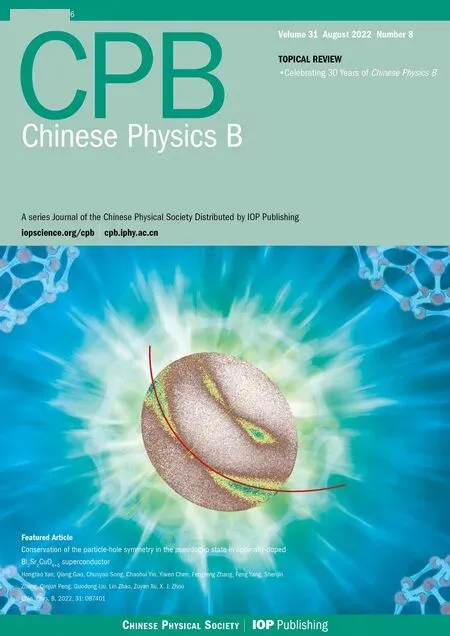Exchange-coupling-induced fourfold magnetic anisotropy in CoFeB/FeRh bilayer grown on SrTiO3(001)
Qingrong Shao(邵傾蓉) Jing Meng(孟婧) Xiaoyan Zhu(朱曉艷)Yali Xie(謝亞麗) Wenjuan Cheng(程文娟) Dongmei Jiang(蔣冬梅)Yang Xu(徐楊) Tian Shang(商恬) and Qingfeng Zhan(詹清峰)
1Key Laboratory of Polar Materials and Devices(MOE),School of Physics and Electronic Science,East China Normal University,Shanghai 200241,China
2Key Laboratory of Magnetic Materials and Devices,Ningbo Institute of Material Technology and Engineering,Chinese Academy of Sciences,Ningbo 315201,China
Keywords: magnetic anisotropy,phase transition,CoFeB/FeRh,exchange coupling
1. Introduction
Magnetic anisotropy is a very important parameter in the application of magnetic thin film devices, which has intrinsic and extrinsic origins. When magnetic materials with cubic structure is epitaxially grown on single crystal substrates,an in-plane fourfold magnetic anisotropy can be observed due to its intrinsic cubic magnetocrystalline anisotropy, such as Fe/MgO(001)[1]and Fe3O4/GaAs(100).[2]In contrast, an amorphous magnetic film cannot show the intrinsic magnetocrystalline anisotropy due to the absence of long-range order in the crystal lattice.Extrinsic magnetic anisotropies can be resulted from various origins,such as shape of materials,[3]mechanical stress,[4,5]and interfacial exchange coupling.[6,7]The last case is prevalent in designing and fabricating magnetic materials and devices. When a ferromagnetic (FM) layer is exchange coupled to an antiferromagnetic(AFM)layer,a hysteresis loop shift and a coercivity enhancement are often observed. This kind of exchange bias(EB)coupling can induce a unidirectional anisotropy and an extra uniaxial anisotropy,for which reason the AFM materials are widely used in spintronic devices as a pinning layer.[8–12]When a soft FM layer with high saturation magnetization is exchange coupled to a hard FM layer with high coercivity, the composite materials may display a high magnetic energy product. This kind of exchange spring coupling is usually employed to design the next generation of permanent magnet materials.[13–15]Although the fourfold magnetic anisotropy is often obtained through the epitaxial growth of an FM layer with cubic structure,it cannot be induced by the interfacial exchange coupling regardless at the FM/AFM or FM/FM interfaces. Different from the exchangecoupling-induced magnetic anisotropy, the fourfold magnetic anisotropy of epitaxial magnetic films is not easy to be tuned due to its intrinsic nature.
The CsCl-type FeRh alloy is AFM at room temperature,undergoes a first-order phase transition to FM as the temperature rises around 370 K,[16–19]and shows a coexistence of AFM and FM phases during the transition. The peculiar magnetic transition gives FeRh film potential application in thermally assisted magnetic recording storage.[20]When an AFM FeRh layer is proximate to a hard FM media of FePt layer,the exchange bias coupling occurring at the interface can increase the coercivity of FePt, thus improve the stability of magnetic information storage. After the occurrence of magnetic transition of FeRh at an elevated temperature, the exchange spring coupling between the FM FeRh and the FePt layer can significantly reduce the coercivity of FePt,thus enable the information writing with a low magnetic field.
Soft FM material of CoFeB displays the excellent magnetic properties such as high spin polarization, high permeability, low coercivity, and low magnetic damping[21–23]due to the unique amorphous structure with the absence of dislocations and grain boundaries.[24,25]Consequently, CoFeB in the form of thin film has been widely used in spintronic devices.[22,23,26–29]Due to the lack of crystal structure,amorphous CoFeB film has no magnetocrystalline anisotropy, but usually reveals a weak uniaxial anisotropy.[30]In this paper,we realized an unusual fourfold magnetic anisotropy in amorphous CoFeB layer by means of exchange coupling to an adjacent FeRh layer which is epitaxially grown on SrTiO3(001)substrate. As the temperature increases, FeRh transfers from AFM to FM states, the induced fourfold magnetic anisotropy of the CoFeB layer switches the orientation from FeRh〈100〉to FeRh〈100〉directions, and the strength is obviously reduced.
2. Experiment
CoFeB(15 nm)/FeRh(50 nm) bilayer was grown onto(001) oriented SrTiO3(STO) substrate by using an ultrahigh vacuum magnetron sputtering system with a base pressure lower than 1.0×10?8Torr (1 Torr=1.33322×102Pa). The STO substrate was pre-annealed at 700?C for an hour and held at 750?C during deposition. FeRh layer was sputtered from a stoichiometric Fe50Rh50target in an argon atmosphere of 3 mTorr,and then was subjected toin situannealing at 780?C for 90 min to promote the atomic ordering. After naturally cooled to room temperature,Co40Fe40B20(CoFeB)layer was deposited on top of the FeRh layer. Reference FeRh(50 nm)and CoFeB(15 nm) single layers were grown on STO(001)by using the same growth parameters. All the samples were coated with a 3-nm Ta layer at room temperature to avoid oxidation before being taken out of the vacuum chamber. X-ray diffraction(XRD)θ–2θandΦ-scans were performed to characterize the crystalline structure and the epitaxial nature.Magnetic property measurement system (MPMS, Quantum Design) was used to characterize the magnetic phase transition.Magneto-optical Kerr effect(MOKE)setup was used to characterize the hysteresis loops at various in-plane orientations of magnetic field. Ferromagnetic resonance(FMR)measurements were carried out to obtain the magnetic anisotropy and the magnetic damping parameters.
3. Result and discussion
Figure 1(a) shows the x-ray diffractionθ–2θpattern of the CoFeB/FeRh bilayer grown on STO(001) substrate. The FeRh(001) and (002) diffraction peaks are clearly seen, indicating the formation of CsCl-type ordered structure with a(001)-preferential growth orientation. No CoFeB peak is detected due to the amorphous structure. The x-rayΦ-scan pattern displays four peaks separated by 90?for both STO substrate and FeRh layer, as shown in Fig. 1(b). The two sets of peaks have a 45?deviation, thus the epitaxial relationship is known to be STO(001)[010]||FeRh(001)[110],as shown in Fig.1(c). Before the subsequent temperature-dependent magnetization (M–T) measurement, a 1-T field cooling process was performed along the STO[100] orientation. The saturation magnetization of the bilayer increases from 415 emu/cc at 300 K to 1075 emu/cc at 400 K, which confirms the presence of antiferromagnetic(AFM)to ferromagnetic(FM)phase transition of FeRh,[17,31]as shown in Fig. 1(d). The reference CoFeB single layer was measured to show a magnetization of 996 emu/cc at 300 K and a slightly reduced value of 964 emu/cc at 400 K. The magnetization of FeRh layer is 143 emu/cc at 300 K and 898 emu/cc at 400 K. The residual magnetization in the AFM state is often observed to be located within 6 nm–8 nm near the top and bottom interfaces of FeRh layer,[32–36]because the presence of antisite defects at the interfaces results in some neighboring Fe–Fe atom pairs changing to FM coupling.[32]The residual magnetization of FeRh grown on STO(001)is slightly larger than that on MgO(001).[32,35]According to the lattice parametersαFeRh= 0.2995 nm,αSTO= 0.3905 nm, andαMgO=0.4216 nm, FeRh film is subjected to a compressive strain of 0.53%when epitaxially grown on MgO(001)substrate,while the compressive strain remarkably increases to 7.8%for FeRh on STO(001).[37]This epitaxial strain can be relaxed through the formation of structural defects.
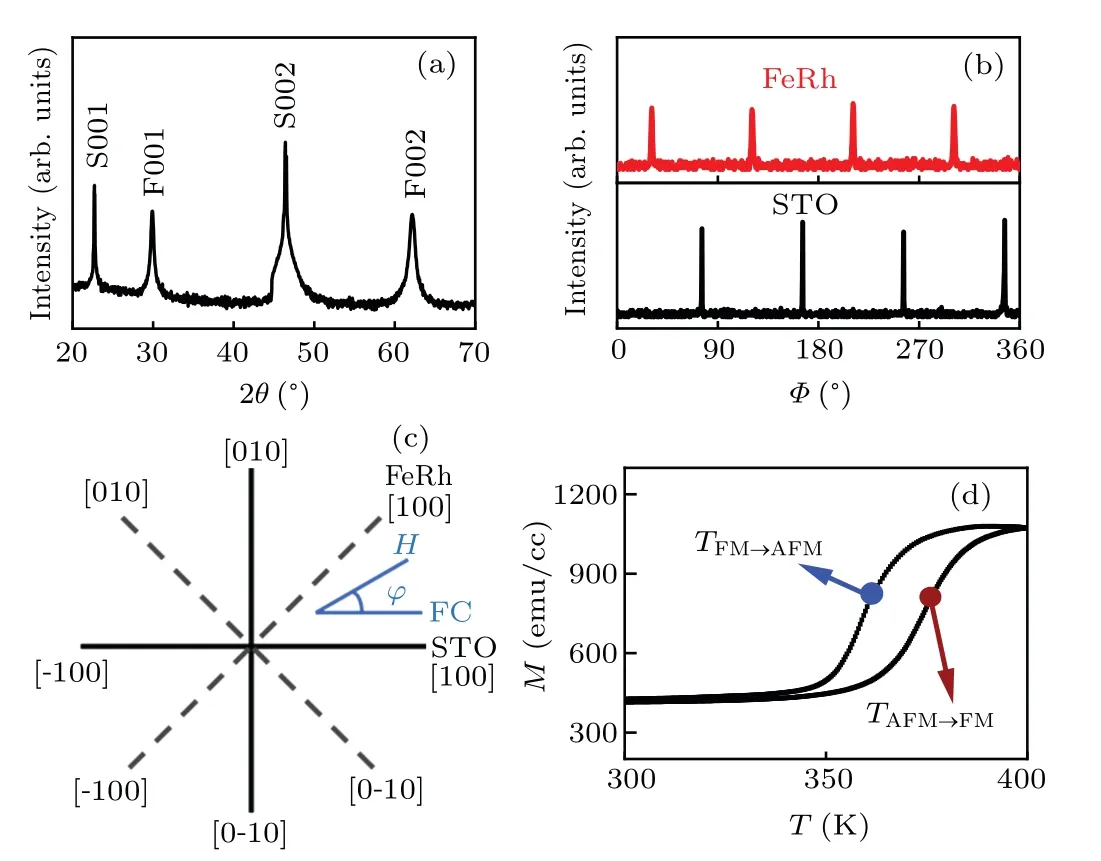
Fig. 1. X-ray (a) θ–2θ scan and (b) Φ scan of the CoFeB/FeRh bilayer grown on STO(001)substrate. The S and F marked on the diffraction peaks indicate STO and FeRh,respectively.(c)Schematic diagram of the epitaxial relationship between FeRh and STO lattices. A 1-T field cooling process was performed along STO[100],then an in-plane external field was applied in subsequent measurements at different angles ? with respect to STO[100].(d) Temperature dependence of magnetization of the CoFeB/FeRh bilayer.The critical temperatures of phase transition in the heating and cooling branches are indicated as well.
Consequently,the large epitaxial strain imposed by STO substrate may lead to a large residual magnetization of FeRh in the AFM state. By taking a derivative of theM–Tcurves,the AFM–FM transition temperatures in the heating and cooling branches are extracted asTAFM→FM=375K andTFM→AFM=359 K, respectively. The thermal hysteresis,i.e., the difference betweenTAFM→FMandTFM→AFM, clearly indicates the first-order of phase transition of FeRh.
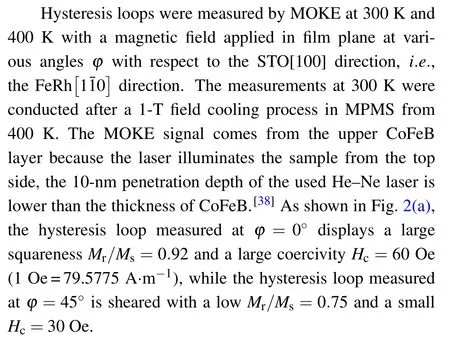

Fig.2. Hysteresis loops of the CoFeB/FeRh bilayer obtained with an external magnetic field applied along the easy axis(EA)and the hard axis(HA)at(a)300 K and(b)400 K.Angular dependence of normalized Mr/Ms and Hc of the bilayer measured at(c)300 K and(d)400 K.
Figures 2(b) shows the hysteresis loops measured at the same two magnetic field orientations at 400 K. The hysteresis loop at?=0?changes to a relatively sheared one withMr/Ms= 0.85 andHc= 40 Oe. Meanwhile, the hysteresis loop at?=45?changes to a relatively square one withMr/Ms=0.94 andHc=42 Oe. Figures 2(c) and 2(d) show the angular dependence ofMr/MsandHcextracted from the hysteresis loops obtained at 300 K and 400 K, respectively.BothMr/MsandHcreveal an in-plane fourfold symmetry. At 300 K when FeRh is in the AFM state, the maximum values appear at?=0?, 90?, 180?, and 270?,i.e., the in-plane FeRh〈110〉directions. While the minimum values are located at?=45?,135?,225?,and 315?,i.e.,the in-plane FeRh〈100〉directions. Because the angular dependence ofMr/MsandHcare direct consequence of magnetic anisotropy, the symmetry ofMr/MsandHcindicates that when exchange coupling to an AFM FeRh layer, the amorphous CoFeB layer displays a fourfold magnetic anisotropy with the easy axes orienting along the FeRh〈110〉direction and the hard axes along the FeRh〈100〉direction. At 400 K when FeRh enters into the FM state,the maximum values of bothMr/MsandHcchange to appear at?=45?,135?,225?,and 315?.The minimum values are located at?=0?,90?,180?,and 270?. Thus,the easy and hard axes of the fourfold magnetic anisotropy in CoFeB layer change to orient along the FeRh〈100〉and〈110〉directions, respectively. In contrast, the reference CoFeB single film grown on STO(001) displays a clear uniaxial magnetic anisotropy and the reference FeRh single film in the FM state reveals a fourfold magnetic anisotropy.
Figures 3(a)and 3(b)show the typical MOKE loops measured along the easy and hard axes for the CoFeB single film at 300 K and the FeRh single film at 400 K,respectively. Figures 3(c)and 3(d)show the corresponding angular dependence ofMr/MsandHcfor the CoFeB and FeRh single films,respectively. The induced fourfold magnetic anisotropy indicates that the cubic magnetocrystalline anisotropy of the epitaxial FeRh layer either in the AFM or FM states can be imprinted into the amorphous CoFeB layer through the AFM/FM and FM/FM interfacial exchange coupling between them.Because the magnetocrystalline anisotropy of FeRh changes from the〈110〉directions in the AFM state to the〈100〉directions in the FM state,[39]the easy and hard axes of the induced fourfold anisotropy in the CoFeB layer are swapped with each other after the occurrence of phase transition of FeRh. Comparing the difference inMr/Msmeasured along the easy and hard axes,it is found that the fourfold magnetic anisotropy of the CoFeB layer induced by the AFM FeRh at 300 K is obviously higher than that by the FM FeRh at 400 K. The coercivities for the reference CoFeB/STO(001)film measured along the easy and hard axes are only 8 Oe and 3 Oe,respectively.It is clearly that the exchange coupling to FeRh layer leads to a remarkable enhancement in the coercivity of CoFeB layer. It is well known that the most common phenomena for an AFM/FM bilayer are exchange bias behaviors with the shift in its hysteresis loop and an increasement of its coercivity.[11,12,40]Although we have observed a fourfold magnetic anisotropy and obviously enhanced coercivities in the CoFeB/FeRh bilayer caused by the interfacial exchange coupling regardless of FeRh in the AFM or FM states, there is no shift in hysteresis loops when FeRh is in the AFM state even after a field cooling process.In previously well-studied AFM/FM bilayers,the pinning and rotatable uncompensated moments in the AFM surface may couple to the FM moments across the interface, respectively leading to the exchange bias field and the increasement of coercivity.The rotatable uncompensated moments can rotate following the FM moments under a magnetic field due to the exchange coupling. The pinned moments have been observed mostly below the rotatable ones. Both kinds of moments are very rare in the commonly used AFM layers, such as IrMn,CoO,etc. Synchrotron methods, such as x-ray magnetic circular dichroism,are usually required to detect them.[41,42]Different from these AFM layers,when FeRh is in the AFM state,a great number of residual FM moments can still be observed to be mostly located at the upper and bottom interfaces.[32]They actually can be viewed as the rotatable uncompensated moments distributed in the AFM matrix and well separate the exchange coupling between the below pinned uncompensated moments and the CoFeB moments. Consequently,only the increase of coercivity but no exchange bias is observed in our CoFeB/FeRh bilayer. It should be noted that the residual FM FeRh phase is different from the FM FeRh phase at an elevated temperature. It may display a magnetocrystalline anisotropy collinear with the AFM matrix, but the strength may reduce due to surface defects. Consequently, the fourfold magnetic anisotropy in the CoFeB layer is imprinted from the AFM FeRh surface with a mixture of the residual FM phase and the AFM matrix.
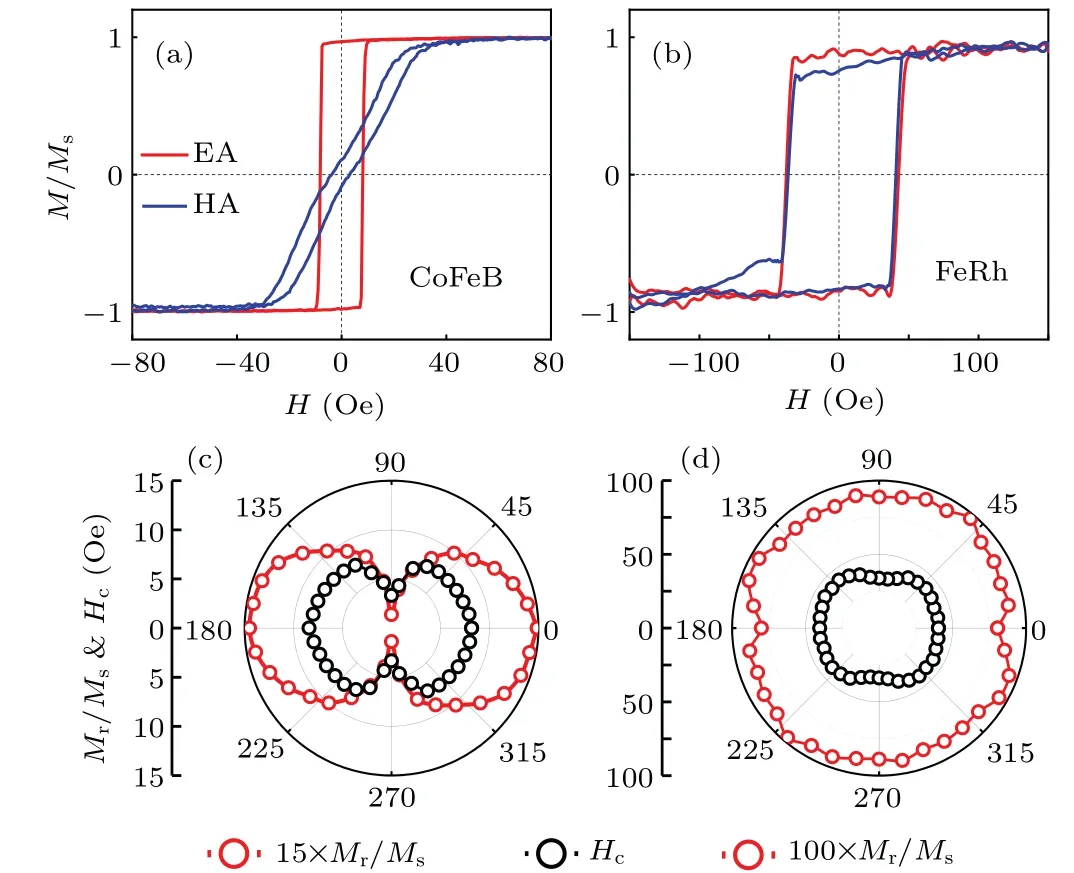
Fig. 3. Hysteresis loops of (a) CoFeB/STO single film at 300 K and (b)FeRh/STO single film at 400 K obtained with an external magnetic field applied along the easy axis (EA) and the hard axis (HA). The corresponding angular dependence of normalized Mr/Ms and Hc of (c) CoFeB/STO film and(d)FeRh/STO film.
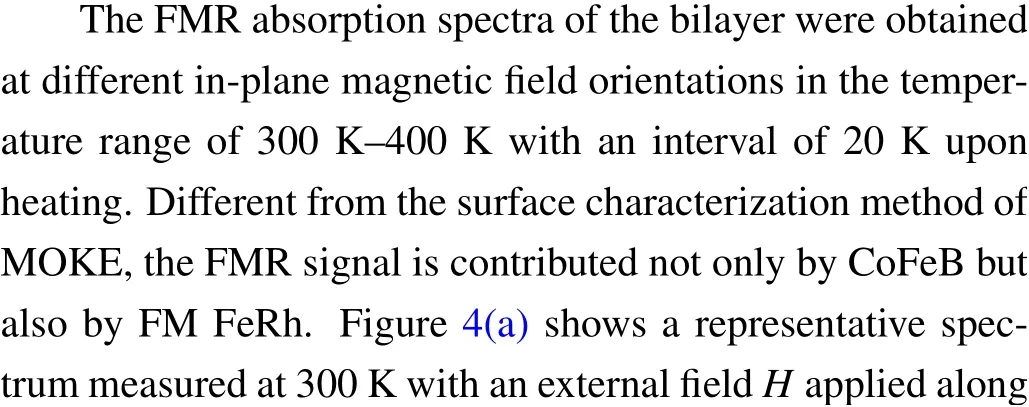


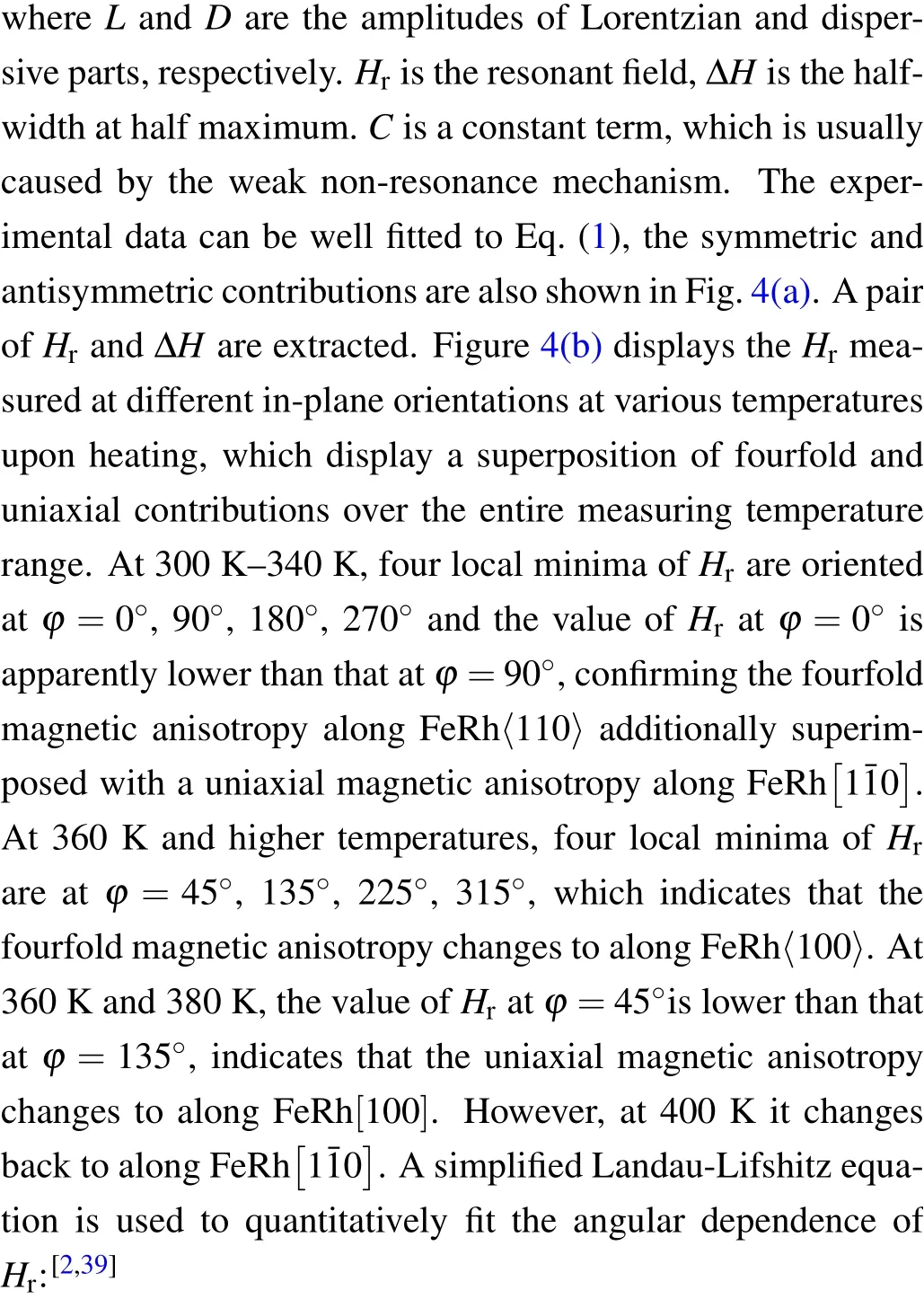

wherefis the microwave frequency fixed at 9.3 GHz in the measurements,γis the gyromagnetic ratio.KuandK1are the in-plane uniaxial and fourfold anisotropy constants, respectively. Figure 4(c) shows the temperature dependence ofK1/MandKu/Mof the bilayer.TheK1/Mhas a small value of 2.7 Oe at 300 K. It significantly increases when crossing the AFM–FM phase transition temperature and reaches a maximum value of 19.3 Oe at 400 K.TheKu/Mhas a small value lower than 2 Oe over the entire measuring temperature range.When FeRh is in the AFM state at 300 K, theK1andKuobtained by FMR are the anisotropies of the CoFeB layer. However, when the temperature rises from 300 K to 400 K, the AFM FeRh gradually transfers to FM,which contributes to the FMR signal.Thus,the obtainedK1andKuare the anisotropies of the coupled FM bilayers.TheK1/Mof the FeRh single film is also measured as 38.4 Oe at 400 K by FMR, which is significantly larger than the value of the bilayer. Obviously, the exchange coupling to the CoFeB layer can significantly reduce theK1/M. The orientation ofKushows a complicated dependence on temperature, which is because of the competition between the different sources. The CoFeB layer itself possesses a uniaxial magnetic anisotropyKuCFB. The ferromagnetic FeRh phase also displays a uniaxial magnetic anisotropyKuFeRh. The exchange coupling between CoFeB and FeRh can additionally induce a uniaxial magnetic anisotropyKuex.When FeRh starts to transfer from AFM to FM,the three components may change with temperatures,resulting in the variation ofKu.
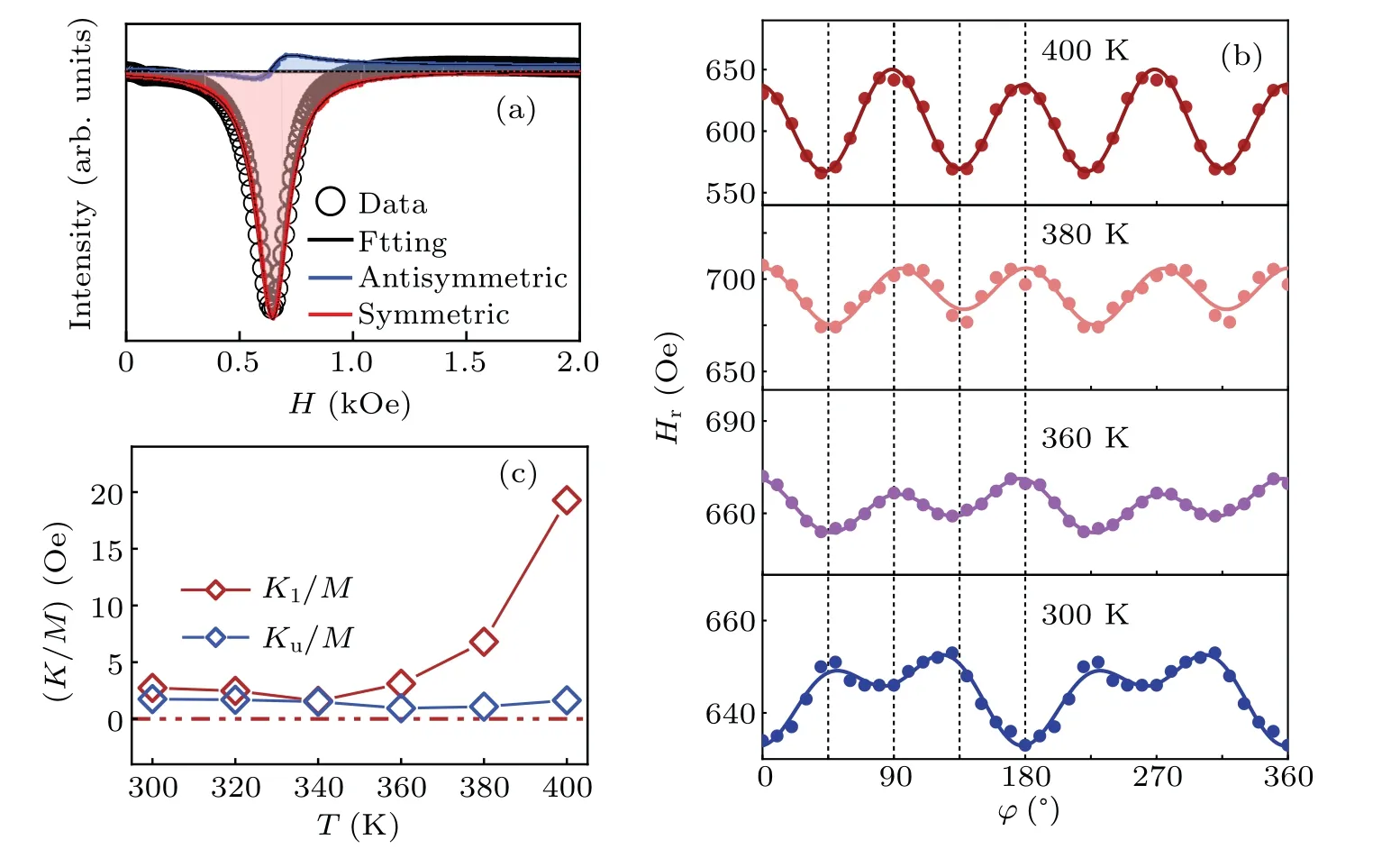
Fig. 4. (a) Representative FMR spectrum (open dots) for the CoFeB/FeRh bilayer measured along FeRh1ˉ10at 300 K. The corresponding fitting result (black line) consists of the symmetric (red line) and antisymmetric (blue line) parts. (b) The extracted resonance field Hr as a function of the in-plane magnetic field orientation ? at different temperatures. The solid lines are the fitting to Eq. (2). (c) Temperature dependence of the fitting parameters of K1/M and Ku/M.


whereΓ0,Γ2, andΓ4are the parameters of the constant,twofold, and fourfold terms in the TMS contribution, respectively. The Gilbert damping together with the TMS constant term forms the effective damping and is expressed asαeff=α+Γ0/2M, which does not vary with the orientations of applied magnetic field. As shown in Fig.5(a), the angular dependent linewidth can be well fitted to Eq.(3).
Figure 5(b)shows the fitting parameter ofαeffas a function of temperature. When FeRh is in the AFM state, theαeffof the CoFeB/FeRh bilayer is as small as 2.9×10?2at 300 K.When FeRh enters into the FM state,theαeffincreases to 5.0×10?2at 400 K.For comparison,theαeffof the CoFeB single film is 1.0×10?2at 300 K, and theαeffof the FeRh single film decreases from 7.9×10?2at 360 K to 5.8×10?2at 400 K. The FMR signal of the nominally AFM FeRh is too weak to be detected when the temperature is below 360 K.It is obviously that the interfacial exchange coupling in the CoFeB/FeRh bilayer can increase the magnetic damping of the soft CoFeB layer and pull down that of the FM FeRh layer, which is consistent with many previous reports on the enhancement ofαeffin FM/AFM systems.[53–56]Theαeffdisplays an anomalously large value of 6.5×10?2at 380 K during the regime of phase transition,which is probably because the AFM FeRh moments stay in an unstable state and can rotates following the FM FeRh moments. This feature is similar to the phenomenon occurred in the FM/AFM exchange biased bilayers,the coercivity displays a peak value when the AFM moments become unstable with reducing the thickness to a critical value.[57]
The fourfold TMS coefficientΓ4is as small as 11.9 Oe at 300 K. As FeRh transfers from the AFM to FM states,theΓ4remarkably increases to 202.2 Oe at 400 K, as show in Fig. 5(c). The change of the fourfold symmetry of ?Hat 360 K indicates that the direction of the maximum scattering changes from FeRh〈100〉to FeRh〈110〉with the occurrence of the AFM–FM phase transition of FeRh. The twofold TMS coefficientΓ2keeps a small value around 6.2 Oe before 340 K and sharply increases to 54.2 Oe at 400 K.Similar to theαeff,theΓ2also displays an anomalously large value of 105.5 Oe at 380 K when FeRh stays in a mixed AFM–FM state.

Fig.5. (a)The linewidth ?H as a function of the in-plane magnetic field orientation ? at different temperatures for the CoFeB/FeRh bilayer.The solid lines are the fitting to Eq.(3). Temperature dependence of(b)the effective damping coefficients αeff and(c)the TMS coefficients of Γ4 and Γ2 for the bilayer. The αeff for the reference CoFeB and FeRh single layers are presented as well.
4. Conclusion
In summary, we fabricated amorphous CoFeB/epitaxial FeRh bilayer on STO(001) substrate. The MOKE measurements indicate that when exchange coupling to the epitaxial FeRh layer, the angular dependence of bothMr/MsandHcof CoFeB layer display a fourfold symmetry which both changes with the magnetic phase transition of FeRh layer.The exchange-coupling-induced fourfold magnetic anisotropy of CoFeB layer changes from FeRh〈110〉to FeRh〈100〉directions with a remarkably reduced strength when FeRh transfers from AFM to FM states upon heating. The anisotropic FMR linewidths obtained at different temperatures demonstrate an obviously enhanced effective magnetic damping and the twomagnon scattering as the magnetic phase transition of FeRh occurs. No shift of hysteresis loop or unidirectional magnetic anisotropy was observed the CoFeB/FeRh bilayer even when FeRh is in the AFM state,which is probably because the residual FM FeRh moments located at the interface can well separate the coupling between the pinned FeRh moments and the CoFeB moments.
Acknowledgements
A portion of this work was performed on the Steady High Magnetic Field Facilities, High Magnetic Field Laboratory,Chinese Academy of Sciences.
Project supported by the National Natural Science Foundation of China (Grant Nos. 11874150, 51871233, and 12174103) and the Natural Science Foundation of Shanghai(Grant Nos.21ZR1420500 and 21JC1402300).
- Chinese Physics B的其它文章
- Magnetic properties of oxides and silicon single crystals
- Non-universal Fermi polaron in quasi two-dimensional quantum gases
- Purification in entanglement distribution with deep quantum neural network
- New insight into the mechanism of DNA polymerase I revealed by single-molecule FRET studies of Klenow fragment
- A 4×4 metal-semiconductor-metal rectangular deep-ultraviolet detector array of Ga2O3 photoconductor with high photo response
- Wake-up effect in Hf0.4Zr0.6O2 ferroelectric thin-film capacitors under a cycling electric field

